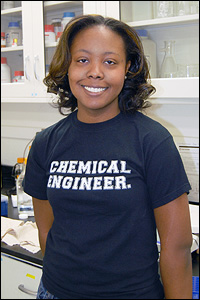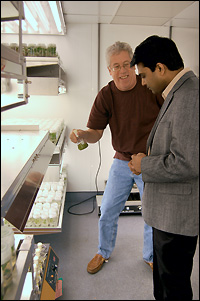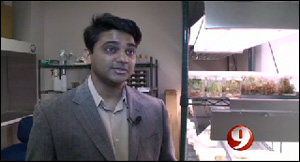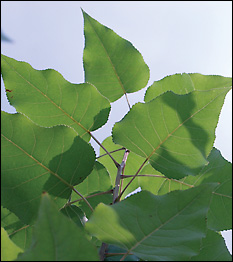News Story
Where Chemical Engineering and Green Thumbs Meet

ChBE junior Lauren Dorsey.
Clark School Department of Chemical and Biomolecular Engineering (ChBE) junior Lauren Dorsey, advised by Assistant Professor Ganesh Sriram, has received a Howard Hughes Medical Institute (HHMI) undergraduate research fellowship to support her efforts to understand how poplar trees (also known as cottonwood or aspen) store and recycle nitrogen, an important nutrient. What she learns could help improve the resilience of agricultural crops and help engineer other plants for use in sustainable biofuel or chemical production.
The competitive HHMI Fellowship program, co-sponsored by HHMI and the University of Maryland's College of Computer, Mathematical, and Natural Sciences, supports the research activities of undergraduates interested in pursuing careers in medical, biological or life sciences. The program's goals are to immerse students in the investigative process, increase their aptitude for research, and provide them with the opportunity to collaborate directly with a faculty mentor.
Dorsey has worked in Sriram's Metabolic Engineering Laboratory since the fall of her sophomore year. She contributes to the group's goal of determining how poplar can be modified into a high-yield, cost-effective and renewable biofuel crop, but her focus on how it processes nitrogen could have far-reaching benefits.
"When nitrogen is depleted, plants' photosynthesis and respiration are reduced, which can lead to increased mortality," she explains. "Nitrogen helps plants resist environmental stresses from disease and drought. Poplar trees are particularly adept at storing and recycling nitrogen, so it's a great model organism to study."
Understanding how plants store and recycle nitrogen, and how to improve their ability to do so, could lead to healthier societies and the development of more sustainable resources. Crops that suffer from nitrogen depletion during droughts could be generically engineered to retain it, allowing them to survive. They may also require less nitrogen-rich fertilizer, which is both expensive and potentially hazardous to the environment. Plants with little or no commercial value could be converted into high-yield biomass crops that provide the ingredients for sustainable and biodegradable products usually made from petroleum, such as fuels, plastics, and synthetic fabrics.
Dorsey uses a technique called metabolic flux analysis to track and map how and where nitrogen is metabolized. She gives her poplars food "labeled" with a nitrogen isotope called 15N, a nitrogen atom containing one extra neutron, which can be detected by a device called a mass spectrometer. She also analyzes the amount and location of a protein called BSP, which is used to store nitrogen. She varies the amount of nitrogen-rich food she gives the plants to determine the effect it has on where the nitrogen is routed and stored, and on how fast it happens.
While much of the Sriram Group's prior research has examined activity at the cellular level, Dorsey is working with poplar plants, a move expected to provide more accurate data about its behavior. "In previous experiments, we thought that whatever happens in our tree is going to happen in each cell," she says. "But isolated cells do not necessarily represent what's going on in different regions, like the bark vs. the leaves." Before turning to the whole plant, she says, the lack of a "big picture" network also left them unable to track BSP.
Dorsey isn't surprised when people ask whether her work seems more like something a biologist would do–even she joined the Sriram Group because she was interested in biofuels, but hadn't thought about the inner workings of the plants they come from.
"I like to think of it as using [what] we learn in our classes for other purposes," she says. "In Kinetics, we studied how reactions proceed—what makes them faster or slower. That's a basic chemical engineering technique. In the Sriram Group, we're applying it to biology." Chemical and biomolecular engineers, she adds, think about biological problems in a different way, particularly because their drive to solve a biological mystery lies in wanting to apply it to a greater problem, like overcoming our dependency on oil. "[We're] trying to solve a problem in a more interdisciplinary way."
Participating in undergraduate research has had a very positive effect on both Dorsey's Clark School experience and her future plans. As a freshman, she wasn't sure what she wanted to do or whether she should major chemical engineering, but her work in the lab helped her decide that she's in the right place.
"I've found I really like doing research," she says, adding that she's now considering pursuing a graduate degree. "It's is one of the best things an undergrad could do to increase their understanding of their classes and their overall interest in engineering."
Published February 11, 2013

















